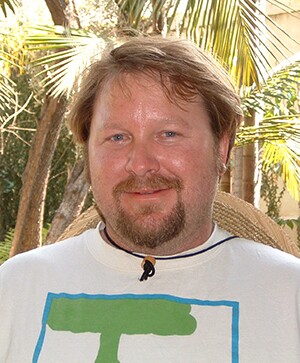He Greened the City: Tom Dwyer Gave the City Some Room to Breathe


For nearly 30 years, Tom Dwyer worked with North East Trees, the non-profit organization responsible for planting some of the first trees and building some of the first parks along the Los Angeles River. He was a tree planter, landscape craftsman, and the cornerstone of a local environmental organization. May 14, while clearing brush on his mountain top home in Eagle Rock, Los Angeles on May 14, 2020, Dwyer suffered a massive heart attack and died. He was 55.
Dwyer was a pioneer in the effort to revitalize the Los Angeles River and “Bring Nature Back” to the City of Los Angeles. Along with a team of landscape architects and arborists, Dwyer helped lead the way in transforming the Los Angeles River from what was once considered a blighted “storm channel” to the now highly valued natural landscape that our city so desperately needs. Where the stretch of river between downtown L.A. and Griffith Park was often used to dump things like old cars and refrigerators, now one mostly finds people walking, cycling, or skating in the shade of native trees that Dwyer planted or simply relaxing in one of the many "pocket" parks that Dwyer helped build. These prototype river projects paved the way for the development of much larger parks such as the Los Angeles State Historic Park, Rio de Los Angeles State Park and many others.

Soon after completing these projects, Dwyer began working along the Arroyo Seco, the tributary stream that starts in the San Gabriel Mountains and makes its way to the Los Angeles River in Lincoln Heights. There he planted thousands of new native trees and enhanced the natural open spaces that line the Arroyo Parkway. While driving on the 110 (Pasadena) freeway, you can witness many beautiful trees planted by Dwyer and his crews.
In addition to doing the early work along our urban waterways, Dwyer was also ahead of his time in many other environmental efforts. He helped construct the first "Green Street" in Los Angeles, a street in Frogtown that intercepts stormwater through a strategically designed drain system while using native oak trees to shade the sidewalks and clean the air. He helped build one of the most ambitious school greening projects in the city as part of the LADWP's "Cool Schools" program. This project included removing nearly 50,000 square feet of asphalt, planting 200 trees, and installing a cistern that captured stormwater from the school playground, which is used to irrigate the turf. Dwyer mastered the construction of bioswales, rain gardens, and other sustainable landscape elements. Most recently, Dwyer oversaw the native plant restoration of Ascot Hills Park, a 100-acre city park in El Sereno. Overall, in the past 30 years, Dwyer is responsible for planting thousands of trees and building dozens of parks, school greening projects, and much more.
Among Dwyer’s most important contributions was the hiring and training of local youth who he mentored and prepared for careers in the "Green Industry." One of his former students who grew up on the east side and is now in charge of the irrigation department for Universal Studios says, "Tom changed my life." This young man got his start working on a youth crew with Dwyer, who taught him about irrigation systems and landscape construction. From there, he went on to work with a local municipality and ultimately at Universal. He is one of many students who learned valuable professional skills from Dwyer. Others went on to college or to work with the City of Los Angeles, the California State Parks, the National Park Service or into the private sector. Part of Dwyer’s appeal was making his work an adventure so that every day was fun, exciting and a challenge. It was never a chore. His crew called themselves the "River Rats," and they were part of a quixotic effort to plant trees, lay irrigation and create beautiful stone sitting walls in the parks that still adorn the banks of the river. At the end of the day, they would relax under the shade of a tarp, flip a wheel barrel over to use as a seat and sit for a while listening to the water and the ducks.

Dwyer grew up in a house that his father built in the foothills between Glendale and La Cañada Flintridge across from the Chevy Chase Country Club. There he played for hours in the chaparral filled canyons and built secret hideouts with his siblings and friends near the local stream. His parents would often take the family on trips to Baja or around the country in their camper, and these experiences drew him close to nature. While attending St. Bede's Catholic school in La Canada, he met a group of friends with whom he stayed close for years. Some later went with him to Loyola High School, where he built lasting relations with his new classmates. Dwyer drove a classic V.W. bus and was known to pile his friends in after school and head to the beach. The brotherhood that he found at Loyola High School was essential and stayed with Dwyer throughout his life. After graduating from Loyola in 1983, Dwyer attended the University of California at Santa Barbara, where he received a degree in Environmental Studies. Upon returning to Los Angeles, he helped found North East Trees along with his sister Lynne Dwyer and Scott Wilson, both of whom were landscape architects and early visionary advocates of the Los Angeles River.
Above all, Dwyer spent his life with Patty Melody, his partner of 24 years. They were known for backpacking and skiing in the Mammoth Mountain area on the weekends or scuba diving in Southern California and Mexico. To some, their house may have resembled an REI warehouse with skis, kayaks, bikes, and scuba gear lying about as if they had just returned from a trip, which they probably had.
Dwyer has joined his parents John and Gail Dwyer and his beautiful dog Ethel who unfortunately have all passed in the last two years. Dwyer is survived by his siblings Wendy, Lynne, Jeff and Jim and his three nieces and nephew Marianne, Summer and Sean and his girlfriend Patty.
Patty Melody asks that those who wish to honor the legacy of Tom Dwyer please give contributions to North East Trees or visit North East Trees online.
Top Image: A walk along the L.A. River. | Taylor Fitz-Gibbon












